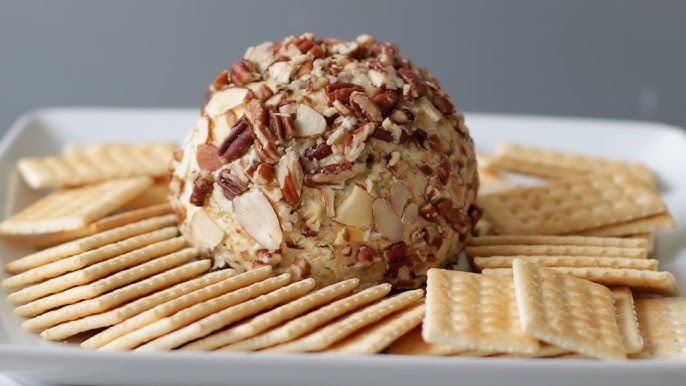Cheese Ball Recipe: Cheese balls are a delightful appetizer, popular for their creamy, savory taste and versatility. Whether it’s for a family gathering, holiday party, or casual snack, a cheese ball offers a perfect blend of flavors, and it’s surprisingly easy to make.
Here’s a detailed guide to crafting the perfect cheese ball that will impress your guests every time.
What is a Cheese Ball?
Cheese balls are essentially a mixture of soft, flavorful cheeses combined with seasonings and rolled into a ball, then coated with ingredients like nuts, herbs, or spices for added texture and taste. Originally popularized in the mid-20th century in the U.S., cheese balls have since become a party staple around the world. Their customizable flavor and easy preparation make them perfect for nearly any occasion.
Ingredients Needed
To make a classic cheese ball, gather the following ingredients:
- Cream Cheese (8 oz) – This serves as the base, giving the cheese ball its creamy texture.
- Cheddar Cheese (1 cup, shredded) – Aged cheddar adds a tangy and sharp flavor.
- Green Onions (2-3 stalks, chopped) – Adds a fresh, mild onion taste.
- Garlic Powder (½ tsp) – For a subtle garlic note.
- Worcestershire Sauce (1 tsp) – Adds a savory depth.
- Salt and Pepper – For seasoning to taste.
Optional Add-Ins for Flavor Variations
- Chopped nuts (like pecans or walnuts) for texture.
- Dried cranberries or raisins for a sweet twist.
- Herbs like parsley or chives for freshness.
- Bacon bits for a smoky flavor.
Equipment Required
You’ll need minimal kitchen tools:
- Mixing Bowl – Large enough to hold all ingredients for easy mixing.
- Spatula or Wooden Spoon – For mixing the cheese mixture thoroughly.
- Plastic Wrap – To help shape and chill the cheese ball.
- Serving Plate – For presentation.
How to Choose the Right Cheese
Cheese selection is crucial for flavor:
- Cream Cheese: Opt for full-fat cream cheese for a richer texture.
- Shredded Cheese: Use a high-quality, flavorful cheese like aged cheddar or Gouda. Shred it freshly if possible, as pre-shredded cheese may contain anti-caking agents that affect texture.
- Soft Cheese Variations: For added creaminess, incorporate cheeses like goat cheese, blue cheese, or brie.
Tips: Balance flavors by pairing tangy or sharp cheeses with creamy, mild cheeses to avoid overpowering tastes.
Preparing the Base Mixture
Softening and Mixing the Cheese
- Start by softening the cream cheese. Let it sit at room temperature for 15–20 minutes until it’s easy to mix.
- In a mixing bowl, combine the softened cream cheese and shredded cheese.
Adding Seasonings and Flavorings
- Add chopped green onions, garlic powder, Worcestershire sauce, salt, and pepper to the cheese mix.
- Stir or fold the mixture with a spatula until all ingredients are evenly distributed. Taste and adjust seasonings as needed.
Shaping the Cheese Ball
Techniques for Forming the Perfect Ball
- Using a spatula, transfer the cheese mixture onto a sheet of plastic wrap.
- Gather the wrap around the cheese and gently shape it into a ball. Press and mold the cheese to form a smooth, even shape.
Tips for Avoiding Sticky Hands
- Keep the cheese in the wrap while shaping to avoid sticking. Refrigerating the mixture briefly before shaping can also help make it more manageable.
Adding Coatings for Texture and Flavor
Coatings add both flavor and visual appeal. Some popular choices include:
- Nuts: Crushed pecans, almonds, or walnuts offer a crunchy texture.
- Herbs: Chopped parsley, chives, or cilantro add a pop of color and freshness.
- Spices and Seeds: Paprika, chili powder, or sesame seeds can add a unique twist.
Applying the Coating
- Spread the coating on a plate, and roll the cheese ball in it until evenly covered.
- Press gently to ensure the coating sticks well.
Chilling the Cheese Ball
Chilling is essential for a firm, sliceable cheese ball.
Why Chilling is Important
Chilling allows flavors to meld, making the cheese ball more cohesive and enhancing taste.
Recommended Chilling Time
Wrap the coated cheese ball in plastic wrap and chill for at least 1 hour, ideally up to 24 hours.
Serving Suggestions
Cheese balls are best served with items that complement their creamy texture. Some serving ideas include:
- Crackers: Choose a variety of sturdy crackers for different textures.
- Vegetable Sticks: Celery, carrots, and bell peppers pair well and add color.
- Fruit Slices: Apple or pear slices add a refreshing sweetness.
Arrange these items around the cheese ball on a serving plate for a visually appealing presentation.
Tips for Making a Perfect Cheese Ball
Avoiding Common Mistakes
- Over-mixing can make the cheese ball too soft. Mix only until ingredients are combined.
Pro Tips for Extra Flavor
- Marinate herbs or spices in oil before adding to the cheese mixture for deeper flavor.
Cheese Ball Variations
- Classic Cheese Ball – Cream cheese and sharp cheddar with a nutty coating.
- Spicy Cheese Ball – Add jalapeños and hot sauce for a spicy twist.
- Herb and Garlic Cheese Ball – Add fresh herbs and roasted garlic for a more aromatic flavor.
- Sweet and Savory Cheese Ball – Mix in dried cranberries and honey for a unique taste.
Storing and Reusing Cheese Balls
- Refrigerating Leftovers – Wrap leftover cheese balls tightly in plastic wrap and store in the fridge for up to a week.
- Freezing Cheese Balls – Freeze in an airtight container for up to 1 month. Allow it to thaw in the fridge before serving.
Making Cheese Balls Ahead of Time
Cheese balls are great for making ahead of time. Prepare it up to two days in advance for the best flavor. If needed, freshen it up with an extra coating before serving.
Healthier Alternatives and Substitutions
For a lighter version, try:
- Low-Fat Cheese: Substitute part or all of the cream cheese with low-fat versions.
- Veggie Additions: Finely chopped bell peppers, cucumbers, or spinach can add nutrition and color.
FAQs about Cheese Ball Recipe
1. What ingredients are typically used in a cheese ball recipe?
A classic cheese ball recipe usually includes cream cheese, shredded cheese (such as cheddar), seasonings, and sometimes extras like chopped nuts, herbs, or spices for added flavor and texture. You can customize it with your favorite mix-ins, such as green onions, bacon bits, or even dried fruit.
2. How do I make a cheese ball?
To make a cheese ball, start by softening cream cheese and mixing it with shredded cheese and seasonings until well-combined. Shape the mixture into a ball, roll it in your desired coating (like nuts or herbs), and refrigerate for at least an hour to firm up before serving.
3. How long does a cheese ball last?
When stored in an airtight container in the refrigerator, a cheese ball can last up to one week. For the best flavor and texture, consume it within a few days.
4. Can I make a cheese ball ahead of time?
Yes, cheese balls are perfect for prepping in advance! You can make one a day or two before your event, which helps the flavors meld. Just keep it wrapped tightly in the refrigerator.
5. What can I serve with a cheese ball?
Cheese balls pair wonderfully with crackers, breadsticks, fresh veggies, or even pretzels. Offer a variety to cater to different tastes and create a more exciting appetizer spread.
Conclusion
Cheese balls are not only easy to make but also highly customizable. With the right ingredients, a few creative coatings, and thoughtful presentation, you can create a cheese ball that suits any occasion. Once you’ve tried this recipe, you’ll see why cheese balls are loved by so many—they’re easy, versatile, and absolutely delicious!
References
For those interested in diving deeper into the art of making cheese balls, we’ve curated a list of reputable sources. These references offer additional insights, expert tips, and variations on the classic cheese ball recipe. By exploring these sources, readers can validate the information shared and discover unique twists to enhance their own creations.
- Allrecipes – Cheese Ball Basics and Variations
- Food Network – Expert Cheese Ball Tips
- Serious Eats – The Science Behind Creamy Cheese Balls
These trusted sources provide valuable knowledge, helping you perfect your cheese ball recipe for any occasion.



